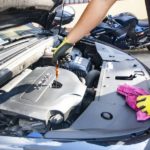Quick Navigation
A car radiator bursting is always scary, and it can happen due to a variety of reasons.
Whether you are looking to narrow down the cause of your radiator or are trying to know what you should be doing to prevent it, you have come to the right place.

To understand why you need to get to the root cause and that’s what we’ll look into now.
7 Top Causes Of Car Radiator Burst
Here are some reasons that cause a car radiator to burst:
1. Damaged Radiator Tank
One common reason which causes a car radiator to burst is damage to the radiator tank. A radiator tank is a storage that contains the coolant or antifreeze.
Since the radiator tank is regularly subjected to heat, it can become less durable with age. It may lead to cracks and even eventual bursting of the car radiator.
If some rocks from the road are knocked up by the tire and hit the radiator tank, it can also get damaged.
You need to take notice if your radiator tank is wearing away over time so that you can replace it when needed and prevent the possibility of a burst.
2. Overheating Due To Water Leak
The car radiator may overheat for several reasons. These include faulty radiator fans, broken water pumps, clogged coolant hoses, or many other causes.
One of these causes is a leak in the cooling system. When there is such a leak, the pressure may build up inside the radiator tank, which can eventually cause the radiator to burst.
You can do different things to prevent your radiator from overheating to prevent a radiator from bursting. You should first turn off and park your car in a shade if you notice it heating up.
Furthermore, it would be best if you regularly replaced your coolant. Most manufacturers recommend flushing and changing the coolant every 30,000 miles.
Low oil can also cause your engine to overheat, so you should maintain oil levels at all times.
3. Leaking Head Gasket
A head gasket aims to seal the combustion gases within cylinders and prevent coolant and engine oils from leaking into the cylinders.
When a head gasket leaks, you may notice coolant puddles under your vehicles and also see that your coolant levels drop.
When the coolant level drops, it can result in overheating of your radiator, which, as explained earlier, could cause a car radiator to burst.
Other signs of a leaking head gasket are white smoke coming out of your car’s exhaust and a strong, acrid smell when your engine is hot.
A leaking head gasket can be dangerous, and it is recommended to tend to it right away. Usually, your local mechanic will be able to fix a leaking head gasket.
However, this can be a little expensive so, some people prefer to solve a head gasket problem at home using leak repair fluid.
4. Bad Radiator Cap
The purpose of a radiator cap is to maintain the appropriate pressure of a vehicle’s cooling system.
A functioning radiator cap would release an appropriate amount of pressure from the radiator and prevent too much pressure from building up.

However, if your radiator cap is faulty, it can cause pressure to build up inside the radiator. It could result in a burst due to the high pressure.
Other indicators of a faulty radiator cap include leaking coolant, overflowing coolant reservoir, low coolant level, and radiator hose collapse. You may also notice puddles of leaking coolant.
If your radiator cap is damaged or faulty in some way, you should replace it right away. It is because it can be dangerous and could cause much damage.
5. Radiator Corrosion
You need to check your radiator regularly for signs of corrosion. If your radiator starts to rust, it could cause your car radiator to burst eventually.
If your radiator starts to rust, it will lead to cracks when the coolant inside the radiator can leak. It would lead to overheating your engine, resulting in the bursting of the radiator.
To prevent this from happening, you should replace your pipework and radiator when you know they are getting old.
While you can fix radiator leaks, it is more likely that these fixes will be temporary if your radiator is old, corroded, and worn out.
At the same time, you should remove the crust that forms on your radiator over time as soon as it builds up. It can be done using white vinegar.
6. Clogged Radiator
It is common for radiators to have lime build up inside them and, as a result, become clogged.
When a radiator becomes clogged, it will prevent coolant from flowing into various other parts of the engine, which will not cool down due to the lack of antifreeze flowing through them.
As a result, the engine will start to overheat. As explained earlier, overheating can cause a car radiator to burst.
To get rid of clogging in your radiator, you must clean it thoroughly. You can do so using dishwasher soap.
Add a few drops of dishwashing soap to a bucket of warm water. Use a sponge to wipe clean the exterior and the interior of your radiator.
Next, dry your radiator with a clean microfiber cloth. It is essential to do this as moisture left on the radiator could cause rust.
7. Faulty Thermostat
Another cause of a car radiator bursting is a lack of temperature control due to a faulty thermostat.
When a thermostat is not functioning well, it leads to a lack of temperature control so that when your engine heats up, it will not be detected, and your car will keep overheating.
As explained earlier, this overheating can cause your car radiator to burst.
While your engine may still run and your car may still move, you do not want to drive your car with a failed thermostat as it can be dangerous.
Instead, it would be best if you replaced it right away. It is not too difficult or expensive to replace your car’s thermostat, and you may even do this yourself.
Final Thoughts
If your car radiator has already burst, you may want to look into one of the above-listed causes so that you can fix the cause and prevent it from happening again.
However, if you are reading this for the sake of knowledge, you should do all you can to prevent your car radiator from bursting.
With the proper precautions, your beloved car will continue to stay in good condition, and you will not have to go through the hassle and financial pain of damage repair of your car.

With comprehensive experience in writing exceptional quality articles and blogs about cars and related stuff, Daniel is one of the finest bloggers and a hardcore car lover we have. He is an ASE certified technician with an across-the-board experience of 10 years in the industry. He could not help tinkering with anything he got his hands on from a young age, which led to his remarkable career in the automotive repair industry.
When he is not under any hood, you can find him on the water or in the woods to pursue his passion for hunting and fishing. He has been writing for multiple sectors and is a regular contributor to several publications.
He currently owns a Nissan 300ZX TT and a Pearl Yellow but plans to upgrade it to 550 HP. His favorites include the Koenigsegg CCX and Lamborghini Diablo 6.0 VT, but for him, the Ferrari 360 Spider is one of the sexiest cars that exists to date.
Being an avid world traveler, he has spent most of his time analyzing the automotive markets, latest technology, and local favorites to enhance his knowledge base. He is currently living in North Caroline, where it’s all about food and coffee and, of course, cars.






